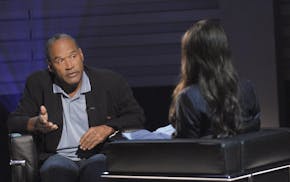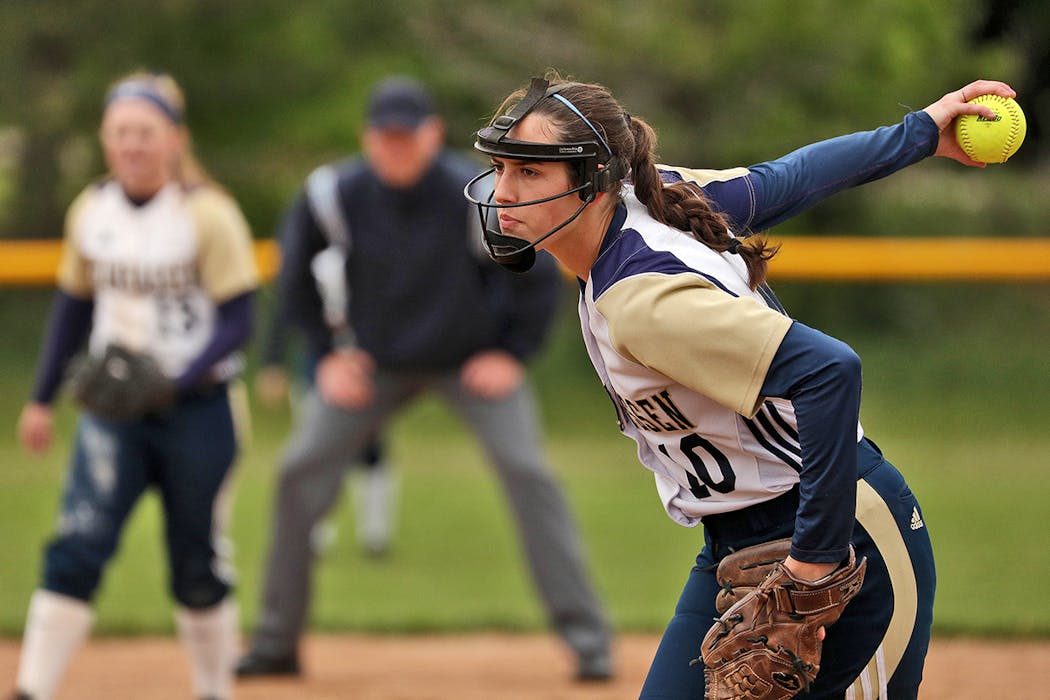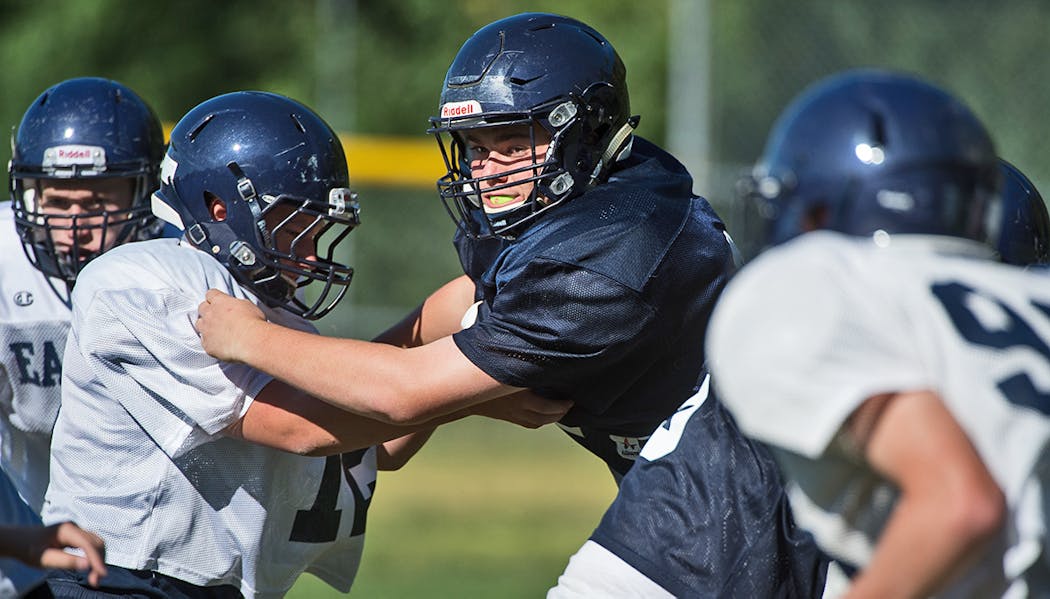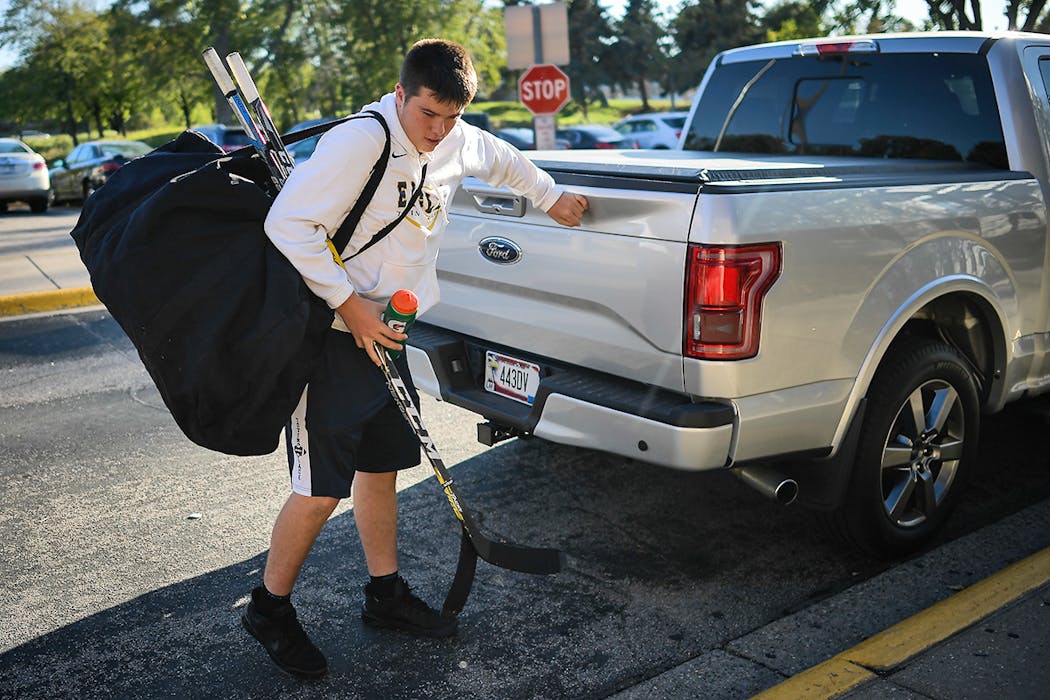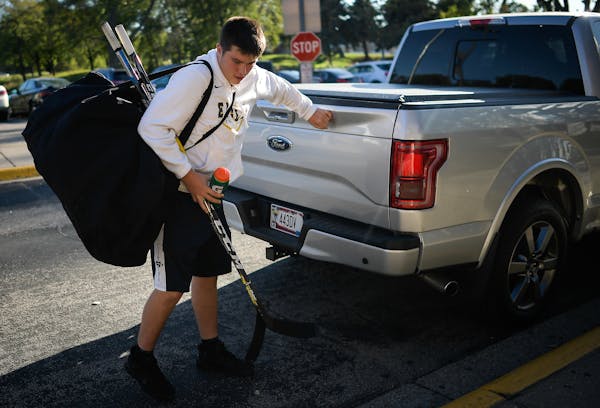The sport Kali O'Keeffe loved at age 12 had turned into a chore, devouring her free time, leaving her out of touch with friends.
She was the starting second baseman for Chanhassen High School's softball team by eighth grade and a major college recruit by 15. But O'Keeffe reached a breaking point before her junior year, on the way back from Tennessee, where her club team had played in a national tournament.
Three hectic years traveling to tournaments across the country and spending countless nights inside a batting cage had taken a toll. She sat down next to her father on a curb outside their roadside hotel. Crying, she told him the pressure of playing year-round softball was just too much.
"When I told my parents, I felt so bad," she said. "They had spent so much money on softball, and I just didn't want to do it anymore."
O'Keeffe is among a generation of Minnesota athletes who have pushed themselves to extremes, developing highly polished skills through year-round dedication to their sport, while their families make major investments of money and time. Her father, Bryan, said the family spent a minimum of $7,500 per year on softball, adding, "That could be on the conservative side."
Youth sports are an estimated $15 billion industry, and the increasing specialization of these budding athletes is irrevocably changing Minnesota's high school landscape in softball, baseball, soccer, hockey, basketball, volleyball and lacrosse — basically, every team sport except football.
The offseason is disappearing, fueled by an explosion of pay-to-play club sports that have scores of young athletes training year-round. While a select few, such as O'Keeffe, become good enough to attract college scholarships, others devote countless extra hours in the quest to make varsity teams.
In the never-ending blur of year-round practices and games, the importance of the high school season itself is shrinking, to the chagrin of many coaches.
"The genie's out of the bottle now," Totino-Grace activities director Mike Smith said. "I don't know how you're going to reverse it. These athletes just don't have very long to be a kid."
The Hill-Murray boys' hockey team, for example, practices with its coach five days per week — in July. The morning after the state volleyball tournament ends next month, hundreds of girls will flock right back to the gym for club volleyball tryouts the next morning. The same happens with basketball.
Teen athletes and their families spend thousands to play for club teams, attend skill-instruction camps and hire personal trainers and college recruiting advisers. A local baseball recruiting service offers a $2,400 guarantee that the teen will play college baseball — or their money back.
"You see families that can't afford to buy groceries, but they'll somehow find a way to get a thousand-dollar pair of skates and get to New York," Hill-Murray boys' hockey coach Bill Lechner said. "It scares me; our priorities are out of whack."
A Star Tribune survey of metro-area coaches, which drew about 140 responses, found that most varsity athletes in volleyball, soccer, basketball, hockey, softball and baseball spend as much time on their sport during the offseason as they do during the high school season. Coaches in volleyball and boys' and girls' soccer reported the highest rates of offseason play by their athletes, sometimes reaching 90 percent.
Chanhassen softball coach Joe Coenen supported O'Keeffe's decision to drop club softball and continue playing varsity ball in the spring. O'Keeffe returned to help the high school win the 2016 Class 4A state championship.
Now she's a freshman at the University of Minnesota, studying nursing, and happily retired from sports. Meanwhile, Coenen said he has a sophomore going through the same stress O'Keeffe did.
"Her whole summer is softball," Coenen said. "For some people, it makes them despise the sport. But for every kid out there whose family would love to cut back, there's a kid who wants to do more."
How it's changed
Lechner remembers a much more leisurely pace to sports when he graduated from Cretin High School in 1971. He and his friends played in a Roseville summer hockey league, nothing that frequently interfered with baseball and summer revelry.
“The kids are put in a tough spot, and I think parents are put in a tough spot, too, with all the pressure with all these offseason programs going on. If everyone would back off a little bit, then it wouldn't be so bad, right? But you feel you have to play.”
Now Lechner runs a summer camp that's "optional" but always well-attended for his Hill-Murray boys' hockey team. Hockey coaches at Wayzata, Bloomington Jefferson and other prominent metro-area programs run these summer camps, too, with parents footing the bill.
"I live on a lake. I coach baseball. I want to golf," Lechner said. "It's not mandatory to run a summer camp, but if I don't, they'd hit me over the head."
The Minnesota State High School League didn't allow coaches to work with players during the summer until 1998. The league had faced pressure from parents who felt their sons and daughters couldn't maximize their potential under the old system.
"Our kids were running off and spending thousands of dollars for training in the offseason," Bloomington Jefferson boys' hockey coach Jeff Lindquist said. "We just felt it was a time to let them train in our community."
The measure, allowing coaching instruction from June 1 to July 31, passed 79-9.
Faribault Bethlehem Academy volleyball coach Franz Boelter was among the nine who voted no, citing the added time commitment being asked of athletes. Now he has worked summer practice sessions into his calendar, and the Cardinals have won seven state championships since 2002.
"I worry that we are asking so much of our kids who are never going to play more than varsity," Boelter said. "They get tired of us."
Football is a different animal. For safety reasons, the high school league limits coaches to 11 full-contact summer football practices.
Kevin Merkle, a former league associate director, said football coaches appreciate that rule because they "can have some time off" knowing "the coach down the road in the next town isn't doing anything more either."
Competing training options
Taylor Manno was the starting pitcher for Chanhassen in the 2016 Class 4A softball championship game. But there was a four-hour rain delay, and when play resumed, Manno was gone. She had a flight to catch to New Jersey, where her club softball team was beginning a tournament the next day.
Manno's teammates, including many like herself who played year-round, didn't blink. They recognized Manno's need to showcase her talents that weekend for East Coast coaches. Sure enough, Manno received a scholarship to play at New Jersey-based Rutgers.
"I don't really regret it because the tournament I went to was the reason Rutgers recruited me," Manno said. "The only part I regret is not being able to celebrate [the state championship] with my teammates."
Athletic directors said stories such as Manno's are becoming more commonplace, citing examples of top basketball players missing high school playoff games to attend national soccer tournaments, and top high school baseball players missing games to go play hockey.
When they aren't playing games, these athletes most likely are working out, often paying trainers to help them.
Former Minneapolis North and University of Connecticut standout Khalid El-Amin runs Ultimate Hoops out of Life Time Fitness in St. Louis Park. Clients pay him between $40 and $100 for hourlong basketball instruction sessions.
Trevor Morning, head performance specialist at Englebert Training Systems (ETS) in Lakeville, said about 500 high school athletes work with trainers through the facility, including several teams from Lakeville North High School. A year-round package at ETS costs about $199 per month.
"To be honest, all athletes should be training year-round," Morning said. "That helps with injury prevention, maintaining strength and maintaining mobility."
For families seeking extra help attracting college recruiters, there's help available — at a price. The Baseball Advising Team is one example, assuring clients they'll play college baseball for $2,400. It works with the Hit Dawg Academy in Chaska, creating a training regimen to follow while the company networks with college coaches on players' behalf.
"I believe that anybody who wants to play college baseball can," said Matt Paulsen, the company's founder. "It doesn't mean you're going to be playing for Florida State."
While some athletes and their families can approach these pursuits with open checkbooks, others can't. In 2016, children from families making $25,000 or less were only half as likely to take part in a team sport as families making at least $100,000, according to the Sports & Fitness Industry Association.
In modern youth sports, overall participation numbers for team sports are declining. In 2016, about 36.9 percent of children ages 6 to 12 participated in a team sport on a regular basis, down from 44.5 percent in 2008, according to the Aspen Institute Sports & Society Program.
"When you play a bigger school, you're not necessarily playing the best athletes in the school," said Mike Grant, Eden Prairie's football coach and activities director. "You're just playing the people that have spent the most money and more time in the gym."
The multisport challenge
Luke Rooker is trying to buck the trend of specializing in one sport. The Totino-Grace freshman plays football and hockey.
"I tell people, 'Hockey is 13 months a year,' " his father, Tom Rooker, said.
When football practice started in August, Luke also played in the Easton Cup, a hockey tournament featuring the top hockey clubs in the Upper Midwest.
One day that week, Rooker arrived at the high school at 7:30 a.m. for football meetings. Football practice lasted until about 11:30. Rooker grabbed lunch, then headed for the Super Rink in Blaine for two hockey games. By the time he got home, it was 9:30 p.m.
"I was a little bit worn out," Rooker said, smiling. "I just wanted to sleep."
The next day, Rooker was back inside the Super Rink for two more hockey games, as temperatures outside climbed above 80 degrees.
"It's the nicest day all week, and we're sitting in an ice rink," said Tom Rooker, perched over a railing, watching his 6-2, 215-pound son play.
Tom Rooker appreciates that Luke's coach with the Minnesota Icemen club team schedules only three tournaments, all in Minnesota. The team practices two to three times per week.
Even without travel, it's not cheap. Luke also attends a skating camp led by former NHL defenseman Dave Langevin and former Gophers and North Stars winger Scott Bjugstad's shooting camp.
Asked how much the family spends just on hockey, Tom Rooker said, "I'd hate to look at the number. And we're on the low end."
Specialization spreads
Orono boys' basketball coach Barry Wohler can relate to what Rooker aspires to be. But Wohler had it easier.
Wohler led Bird Island-Lake Lillian to back-to-back football and basketball state championships in high school. He played baseball and basketball for the Gophers in the early 1980s and played baseball professionally, climbing as high as Class AAA.
"If the rules were what they are today, I wouldn't have played baseball," Wohler said. "I loved basketball. I would have gone to all of those AAU tournaments and wouldn't have had time for anything else."
On last year's Maple Grove girls' soccer team, 19 of the 21 varsity players were strictly soccer players, having shed obligations for any other sport.
In a University of Wisconsin study released this summer, 30 percent of the 12-year-old athletes surveyed already were highly specialized in one sport, meaning they trained at least eight months per year for that sport and had quit one sport to focus on another. By age 15, the number of highly specialized athletes was 47 percent.
If scholarships are the goal, there are no guarantees. According to the NCAA, only 2 percent of all high school athletes receive some form of college scholarship. Four years ago, UCLA researchers surveyed 296 Division I athletes and found that 70 percent of them waited to specialize in one sport until at least age 12.
"There's this myth out there that the reason kids specialize is to get a college scholarship," said Timothy McGuine, who led the Wisconsin study. "Talking to parents and kids, we started seeing that specialization was really about just getting on their high school team."
“The more parents become invested financially in their kids' sports lives, usually the more emotionally invested they become. So, if you're spending $20,000 a year to train your kid up as a soccer player, that kid comes back to you at age 13 and says, 'I don't want to play soccer anymore,' you're going to push back because you've got a $100,000 investment. When we were kids, I don't think my parents spent $200 on my youth sports life, so if I wanted to quit, it was OK with them.”
Micki Husnik echoed that this August, watching daughter Lauren compete for North Branch in a preseason volleyball tournament in Burnsville. Lauren Husnik isn't on a mission to play college volleyball; she just loves being part of a North Branch team that made the state tournament two years ago.
"To be a good varsity player, you have to commit yourself year-round," Micki Husnik said. "Like we always tell her, there's always somebody getting better, faster, stronger — ready to take your spot."
Injury risk increases
McGuine's study gathered data from 29 Wisconsin high school athletic departments, studying 1,544 injuries. The conclusions showed that athletes who specialized in one sport were about 50 percent more likely than nonspecialized athletes to suffer lower-body injuries, such as ankle sprains, knee tendinitis and stress fractures.
Dr. Heather Bergeson, who specializes in overuse injuries for Tria Orthopaedic Center in the Twin Cities, said she is seeing more foot stress fractures among youth soccer players and more elbow ligament replacement surgeries among youth baseball players.
To help protect young arms, the high school league adopted new pitch count rules this year, capping the number of pitches any player can throw in one day. Pitchers who throw more than 50 pitches must receive at least two days of rest before pitching again.
Bergeson also has seen an increase in lower-back stress fractures, including some in patients as young as 8. She said this used to be primarily a gymnastics injury, but she's seeing it from volleyball, basketball and hockey.
"It's a real epidemic of overuse injuries," Bergeson said.
Grinding away
Kali O'Keeffe liked everything about club softball when she started playing for the Minnesota Renegades after sixth grade.
"The coaches were phenomenal," she said. "We'd hit all the time, and they took video of your swing. That's where I saw the most improvement."
Over the years, the Renegades played tournaments from Tennessee to California. But heading into her junior year, O'Keeffe had reached her limit.
The club team's summer regimen included a four-hour morning practice. There was an afternoon break, but the team might have a 5 p.m. game in Rosemount, for example, so there would be another car pool, with players arriving two hours before first pitch. Sometimes at weekend tournaments, the team would be up until 11:30 p.m., analyzing video.
"At the end of the summer, it was like I didn't have a summer, all I had was softball," O'Keeffe said. "It got to the point where I was losing sleep over it because I wanted to have memories with my friends."
During the winter, O'Keeffe juggled softball and hockey, but softball was the primary focus. She drew interest from Indiana, Loyola (Chicago), Northern Iowa and St. Thomas before shutting down her recruiting after the curbside conversation with her dad.
"She made her decision, and we supported it," Bryan O'Keeffe said. "She didn't want her legacy to be known strictly as a softball player. There's so much more to her as a person."
The future
Last March, the Arizona Interscholastic Association passed a rule allowing its high school coaches to work with players not just during the season and summer, but year-round.
"I can't wrap my head around how that's good for a kid year-round," said Smith at Totino-Grace.
Long a hockey mecca, Minnesota has become a growing hotbed for college volleyball, basketball and softball recruits, with increasing visibility for athletes in baseball, soccer and lacrosse. Success breeds success, but if Arizona's decision is any indication, the Minnesota State High School League could face increasing pressure to loosen coaching restrictions.
Asked to predict what Minnesota high school sports will look like in 20 years, Wohler said he wonders if all sports will be run through clubs, instead of the high schools. That's the European way.
Meantime, increasingly younger American children are taking their training year-round. Some make that decision even before middle school.
"That's just sad," Kali O'Keeffe said. "I feel bad for kids who don't know what they're getting into."
Joe Christensen • 612-673-7844
Survey of coaches about offseason sports
How much have offseason club sports and training changed the high school sports scene? The Star Tribune asked metro-area coaches to describe how their sport has changed in the last 20 to 25 years with regard to the offseason. In survey responses from about 140 coaches, here's what they said:
• Most varsity athletes in volleyball, soccer, basketball, hockey, softball and baseball spend as much time on their sport during the offseason as they do during the season.
• Volleyball and soccer lead the way when it comes to varsity athletes playing with offseason club or organized teams. But more than half of those who play hockey, softball and basketball also play for nonschool teams as well.
• Offseason training with specialists working on skill and strength development is most common in hockey, where about 60 percent of boys' and girls' players participate. In other team sports, many average about one in three athletes who train this way for part or most of the offseason.
• With no club teams to speak of in football, the high school experience appears least-affected by offseason team play. But nearly one in three players working out in some fashion to support their development for the high school varsity team.
Mbappé scores twice as PSG beats Barcelona to reverse 1st-leg loss and reach Champions League semis
Dortmund digs deep to beat Atlético 4-2 and reach Champions League semifinals with 5-4 aggregate win
Injuries are limiting Antetokounmpo and Lillard as Bucks start playoff preparations
Wild's defense had all kinds of problems — and one breakout star
